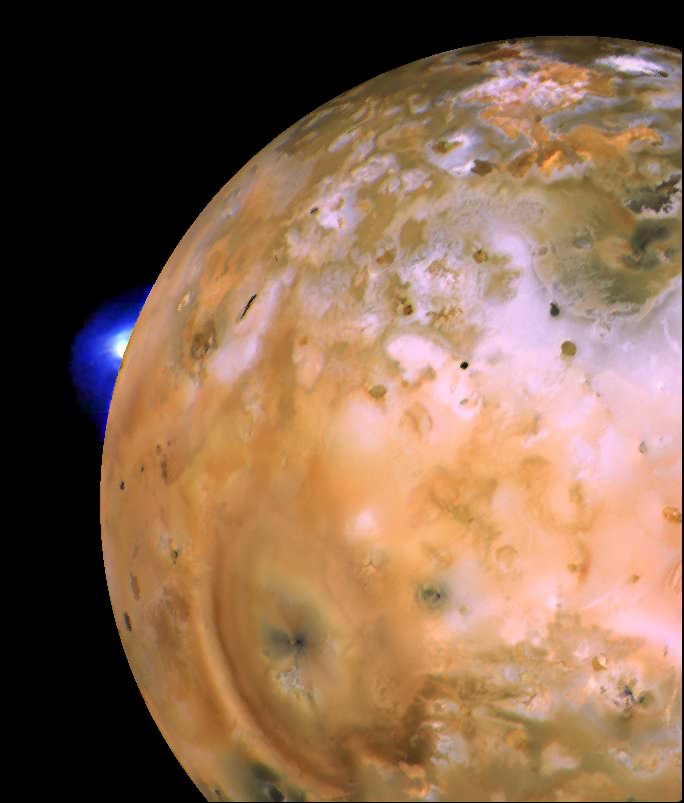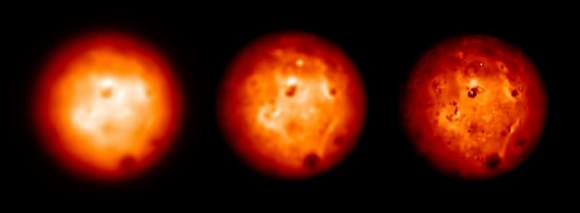Although space missions Voyager and Galileo observed evidence of volcanic activity on Io, it was a faint blue plume at the edge of Io’s limb in a highly-enhanced image from Voyager that first offered evidence of the moon’s turbulent nature.
You fancy yourself an armchair astronomer? A group of California researchers have stepped it up a notch by monitoring the intense volcanic eruptions on Jupiter’s strangest moon Io from the comfort of their home.
Io, the innermost of the four largest moons around Jupiter, or the Galilean moons, is the most volcanically active object in the Solar System with more than 400 active volcanoes spitting out plumes of sulfur and sulfur dioxide. Scientists think a gravitational tug-of-war with Jupiter is one cause of Io’s intense vulcanism. Researchers point out that most of the processes are not well understood. While Io’s eruptions can’t be seen directly from Earth, a team led by Frank Marchis, a researcher at the Carl Sagan Center of the SETI Institute have come up with an unique combination of Earth-based telescope arrays and archival imagery from the Voyager and Galileo probes, according to a press release. The team announced their findings at the 2012 Division of Planetary Sciences meeting today in Reno, Nevada.
“Since our first observation of Io in 2001 using the W. M. Keck II 10-m telescope from the top of Mauna Kea in Hawaii and its AO (adaptive optics) system, our group became very excited about the technology,” says Marchis. “We also began using AO at the Very Large Telescope in Chile, and at the Gemini North telescope in Hawaii. The technology has improved over the years, and the image quality and usefulness of those complex instruments has made them part of the essential instrument suite for large telescopes.”
A faint blue plume on a grainy and highly enhanced image from Voyager 1 first hinted at Io’s dynamic nature. Voyager’s cameras showed a bizarre terrain of volcanic fields, dark spots and active plumes. Scientists nicknamed it the “Pizza Moon.” NASA’s Galileo probe observed more than 160 active volcanoes in various stages of eruption during its looping tour of the solar system’s largest planet.
But crystal clear pictures from Galileo ceased in 2003. Observing a Moon-sized object at the incredible distance to Jupiter from Earth is a challenge because of the blurring caused by Earth’s stirring atmosphere. Since 2001, all large 8- to 10-meter telescopes have been equipped with adaptive optics that correct for that blur. Since 2003, Marchis and his team have gathered about 40 cycles of observations of Io in the near-infrared showing details as small as 100 kilometers, or 60 miles, on the surface of the moon.
Observations of several bright & young eruptions detected at short wavelengths (~2.1 microns) on the top and longer wavelengths (~3.2 microns) on the bottom since 2004 using the W. M. Keck 10-meter telescope (May 2004, Aug 2007, Sep 2007, July 2009), the Gemini North 8-meter telescope (Aug 2007), and the ESO VLT-Yepun 8-meter telescope (Feb 2007), all with their adaptive optics systems. The thermal signature of the Tvashtar outburst can be seen near the north pole on images collected in 2007. A new eruption on Pillan Patera was seen in Aug 2007. A young and bright eruption was detected on Loki Patera in July 2009. This is the last bright eruption that was detected in our survey; since then, Io’s volcanic activity has been quiescent. Credit: F. Marchis
“Spacecraft have only been able to capture fleeting glimpses of Io’s volcanoes, Voyager for a few months, Galileo a few years, and New Horizons a few days. Ground-based observations, on the other hand, can continue to monitor Io’s volcanoes over long time-scales. The more telescopes looking at Io, the better time coverage we can obtain.” Said Julie Rathbun from Redlands University, a planetary scientist not directly involved in this study but who has conducted monitoring of Io with NASA’s IRTF 3-meter telescope for more than 15 years. “AO observations from 8-10m class telescopes are a dramatic improvement in spatial resolution over previous ground-based observations. Soon they will not only be our only way to monitor Io’s volcanoes, but the best way. We should be making these observations more often.”
Simulation of observations of Io using the W. M. Keck telescope and its current AO system, a next-generation AO system mounted on the W. M. Keck telescope (KNGAO), and the Thirty Meter Telescope (TMT) equipped with its AO system (NFIRAOS). The spatial resolution on the center of Io provided by these AO systems is respectively 140 km, 110 km and 35 km in the H band (1.6 microns). Two young eruptive centers labeled A & B can be detected only on the TMT observations. The KNGAO instrument detected the brightest eruption labeled A. Credit: F. Marchis
According to the team, observations reveal a series of young and energetic eruptions called outbursts. These events stand out indicating a high eruption temperature. Coincidentally, the team observed the awakening of the volcano Tvashtar while New Horizons slingshot past Jupiter on its way to Pluto. The eruption lasted from April 2006 to September 2007. Older observations from Galileo show a similar eruption pattern in 1999 lasting for 15 months.
“The episodicity of these volcanoes points to a regular recharge of magma storage chambers” said Ashley Davies a volcanologist at the Jet Propulsion Laboratory, California Institute of Technology, and a member of the study. “This will allow us to model the eruption process and understand the how heat is removed from Io’s deep interior by this particular style of volcanic activity.”
The team found four additional eruptions including a previously unobserved active volcano in 2004. The new sporadic blast accounted for about 10 percent of Io’s average thermal output, according to Marchis. The outburst was more energetic than Tvashtar in 2001. While the team continues to study Io, they have noted that since September 2010, the crazily active moon has been mostly quiet. A dozen or so permanent, low temperature eruptions dot the globe but the team has not detected the young, fire fountain style eruptions seen before.
“The next giant leap in the field of planetary astronomy is the arrival of Giant Segmented Mirror Telescopes, such as the Thirty Meter Telescope expected to be available in 2021. It will provide a spatial resolution of 35 km in the near-infrared, equivalent to the spatial resolution of global observations taken by the Galileo spacecraft. When pointed at Io, these telescopes will offer the equivalent of a spacecraft flyby of the satellite,” Marchis said.
Source: SETI



